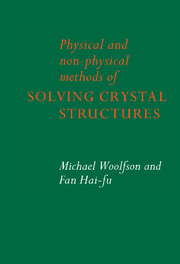Book contents
- Frontmatter
- Contents
- Preface
- 1 The basics of X-ray diffraction theory
- 2 The Patterson and heavy-atom methods
- 3 Direct methods
- 4 The basics of isomorphous replacement and anomalous scattering
- 5 Further aspects of the isomorphous replacement method
- 6 Use of anomalous scattering data
- 7 Phase extension and refinement
- 8 Multiple-beam scattering methods
- References
- Sources of non-original figures
- Index
8 - Multiple-beam scattering methods
Published online by Cambridge University Press: 24 November 2009
- Frontmatter
- Contents
- Preface
- 1 The basics of X-ray diffraction theory
- 2 The Patterson and heavy-atom methods
- 3 Direct methods
- 4 The basics of isomorphous replacement and anomalous scattering
- 5 Further aspects of the isomorphous replacement method
- 6 Use of anomalous scattering data
- 7 Phase extension and refinement
- 8 Multiple-beam scattering methods
- References
- Sources of non-original figures
- Index
Summary
Multiple-beam scattering
A description of multiple-beam scattering
In fig. 1.12 there is shown a graphical means of determining the condition under which a particular diffracted beam will be produced. If the reciprocal lattice point at position s is the only one that touches the sphere of reflection then the associated diffracted beam will be the only one to occur – except of course for the straight-through diffracted beam, corresponding to the point O, which always occurs. Such a situation is described as two-beam diffraction. It is also possible to have more than two reciprocal lattice points on the surface of the reflecting sphere and in fig. 8.1 the points O, P and Q lie on the surface corresponding to the reciprocal-lattice vectors 0, h and k. This would be a case of three-beam diffraction. Four- and more beam diffraction is also possible but here we shall be restricting our attention to the three-beam case.
The line CQ in fig. 8.1 gives the direction of the k diffracted beam. Let us suppose that a beam of radiation was incident on the crystal from that direction. The crystal would still be in the same orientation, as would be the reciprocal lattice which is rigidly attached to the crystal, and the sphere of reflection would be displaced to put the new origin point, O, on the old point Q. It is now clear that after the displacement the reciprocal lattice point h – k will now fall at the same point as P and hence that this diffracted beam would occur.
- Type
- Chapter
- Information
- Physical and Non-Physical Methods of Solving Crystal Structures , pp. 244 - 263Publisher: Cambridge University PressPrint publication year: 1995

